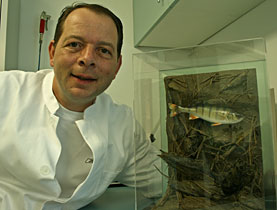Small fish wins big prize

If you're not interested in fish, you probably haven't heard of Matthias Fahrni. But in the world of taxidermy, he's a very big fish indeed.
Fahrni, who lives near Biel in western Switzerland, is a two-time world champion in the fish category.
“My speciality is working with fish which are considered impossible to prepare,” he told swissinfo. The smaller it is, the more difficult. The fish which gave him the 2008 championship was a bullhead only nine centimetres long.
Fahrni works with tiny tools, some of which are taken from human dental and eye surgery, some he has had to adapt himself. His inventiveness is one of the qualities which keeps him ahead of his rivals.
Modern taxidermy is a hi-tech business. “We hate it when people talk about stuffing. It has nothing to do with that any more,” he said.
The fish skin is not stuffed, but laid over an artificial body of polyurethane foam. To get the necessary accuracy of size and shape, Fahrni uses a special microscope, camera and computer programme to record every detail of the fish while it is still alive.
“I need very precise measurements to make the body. Every tenth of a millimetre matters,” he explained. “And a dead fish loses its colour very quickly, especially the eye, so good photos of the live fish are important.”
Long-standing interest
Fahrni has been interested in fish since he was a child. His interest in taxidermy was aroused when as a teenager he saw fish trophies in restaurants. “They were so awful, more like zombies than fish. I thought it must be possible to get better results.”
So he started experimenting – in his mother’s laundry room. “There was potential for conflict,” he admitted. “She with her clean washing, me with my formalin tanks.”
The self-taught Fahrni has always been a pioneer, not least because there was very little material available to help him beyond the basics.
And now, despite being a world leader – “the Mozart of Taxidermy”, as colleagues called him at the recent championship in Salzburg – it is not easy to live from this work. So at the risk of appearing selfish, he is not giving away his secrets.
“I have enough rewards with titles and so on, but I’d like to be able to live like any normal person from what I do. I shan’t take my knowledge to the grave, but this is not the moment to pass it on.”
What makes a good taxidermist? Study and hard work are not enough, Fahrni believes.
“I think it is a gift from God,” he says, adding that concentration and perseverance are also important. “You need to be hard with yourself. I sacrificed many other things which would have been interesting to do.”
Problems
Fahrni says that for many years his life was full of problems. “I was too addicted, too obsessed with what I did. It took much too much of my life away,” he said, explaining that for 12 years he couldn’t earn a living wage, partly because he lost himself in unnecessary details.
Things reached a crisis and Fahrni felt desperate. “Then I became a Christian. I found a belief in Jesus Christ,” he said. “That saved my life.”
He gave up taxidermy – for ever, he thought. He got married, bought a house and started to live a “normal” life.
Four years later, he has upped tools again. He describes his experience as being like that of Job in the Bible, who was tested to see if he was ready to give everything up. “In the end he got it back, and more, much more.”
He is now refurbishing his studio and preparing to devote himself to taxidermy once again.
Beauty and intelligence
Fahrni keeps an aquarium, not only to study the fish but because of the pleasure they give him.
“They are not as dumb as people think,” he maintains. “At first, when I have just caught them, they are very shy, but then they start to know me. They don’t try to hide when I come, although they dart off if it is someone else.”
He admits that he thinks more and more about the beauty of creation and when he is fishing wonders whether to kill his catch or simply admire its beauty. “But I don’t think this will stop my work.”
Most of his fish go to museums. He thinks it important to keep a record for future generations who may never be able to see the fish in the wild.
“I have no problem when I want to eat a nice fried fish, either,” he smiles.
swissinfo, Julia Slater in Aegerten
Matthias Fahrni was born 1969 and grew up in Worben between Bern and Biel.
He now lives in Aegerten, near Biel, where he has his studio.
In addition to being a taxidermist, he is also a qualified electrician.
He won his first world championship in 2003, and the second in Salzburg, Austria, in 2008.
His winning entry at Salzburg, a bullhead, is now displayed in the Natural History Museum in Solothurn.
Most of his work is done for museums.

In compliance with the JTI standards
More: SWI swissinfo.ch certified by the Journalism Trust Initiative
You can find an overview of ongoing debates with our journalists here. Please join us!
If you want to start a conversation about a topic raised in this article or want to report factual errors, email us at english@swissinfo.ch.